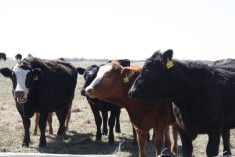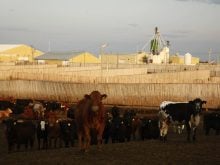This cattle market information is selected from the weekly report from Canfax, a division of the Canadian Cattlemen’s Association. More market information, analysis and statistics are available by becoming a Canfax subscriber by calling 403-275-5110 or at www.canfax.ca.
Fed market remains strong
The western Canadian fed market still has wind in its sails but this is not necessarily the case for the U.S. and Ontario, as both of these markets have either traded steady or lower.
Read Also

Flax sector sees omega-3 opportunity
SASKATOON — A global shortage of omega-3 oils could be an opportunity for the flax sector, says an industry official….
Trading $5.50 per hundredweight higher, western Canadian fed prices averaged $237 per cwt. With higher prices and stronger basis levels, producers sold more cattle than they planned. Most of the cattle that were marketed were fed calves, while a small percentage were yearlings. Competition on the cash market was decent with both major packers buying cattle.
Dressed sales were reported from $393-$398 per cwt. delivered. Cattle that traded were being scheduled for pick up anywhere from one to three weeks.
Western Canadian fed slaughter for the week ending May 13 totaled just under 39,000 head, eight percent lower than last year.
In Ontario, dressed sales were reported at $375 per cwt. delivered, fully steady with bids and sales seen two weeks ago. With the TruHarvest plant not slaughtering cattle and more eastern fed cattle being exported to the U.S., it has taken a bite out of domestic beef production. Year-to-date eastern Canadian fed beef production is down 10 percent compared to last year.
Dressed sales in Iowa and Nebraska ranged from US$280-$282 per cwt., steady to $2 per cwt. higher than the previous week. Live sales in the northern feeding states ranged from $176-$178 per cwt., steady to $1 per cwt. higher. Live sales in Texas and Kansas were at mostly $170 per cwt., fully steady.
Beef production has generally been below last year. The all-fresh beef retail price for the month of April was reported at $7.33 per lb., one percent higher than March and down slightly from last year.
Cow price eases
Spotty moisture conditions and strong salvage prices continue to flush slaughter cows to auction. D2 slaughter cows eased almost $2 per cwt. lower last week to $147.83 per cwt., and D3 cows traded sideways at $131.90 per cwt. Dressed cow bids rallied to new highs last week, up $5 per cwt., ranging from $285-$295 per cwt. delivered.
This week’s average D2 cow/Alberta steer price spread continued to narrow to around 74 percent. Butcher bull prices rallied $2.28 per cwt. higher to $158.56 per cwt. Western Canadian non-fed slaughter for the week ending May 13 was 19 percent larger than the previous week at 6,489 head and year-to-date was up nine percent to 147,594 head.
If pasture conditions don’t improve, a few more cows could be marketed in June.
Cutouts mixed
U.S. cutouts traded mixed last week, with Choice down 2.4 percent to average and Select steady. Since the first of May, Choice cutout values are 18 percent higher than last year and almost five percent higher than the five-year average. Select cutouts were in the $284-$285 per cwt. range.
Feeders in demand
Strong demand continued for all types of feeders last week and average prices rallied $1.50-$2.50 per cwt. higher. The supply and quality of light calves is seasonally deteriorating and weekly prices vary accordingly. Grass interest continues for larger calves, and it should be noted that all 500-800 lb. feeders are trading at or within $1 per cwt. of historical record highs.
Record high fed cattle prices and profitable feeding margins are also fueling interest for larger calf and yearling bunk replacements to place against the fourth quarter fed market.
December live cattle futures have rallied around $3 per cwt. higher over the past several weeks and are providing positive hedging opportunities.
With moisture uncertainty heading into summer, feeders opted to pay for weight this week and 1,050 lb. steers for deferred July delivery garnered a $10 per cwt. premium to spot.
Weekly auction volumes were steady with the previous week at 21,949 head and were four percent smaller than the same week last year. Year-to-date auction volumes were three percent larger than year ago totaling 532,239 head, with forward sold yearlings adding to the numbers. Canadian feeder exports to the U.S. for the week ending May 6 were the largest seen so far this year, up two percent from two weeks ago to 5,290 head, and were five percent larger than the same week last year. Year-to-date feeder exports were 49 percent lower than a year ago totaling 53,564 head.
This cattle market information is selected from the weekly report from Canfax, a division of the Canadian Cattlemen’s Association. More market information, analysis and statistics are available by becoming a Canfax subscriber by calling 403-275-5110 or at www.canfax.ca.














